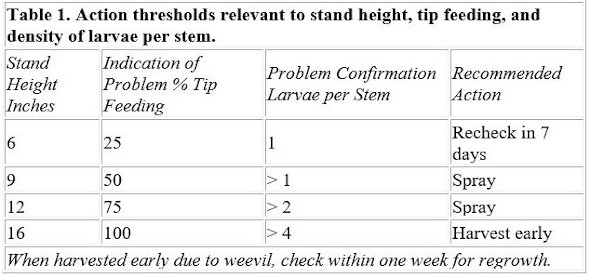By Kelley Tilmon and Aaron Wilson et.al.
Though it seems like spring has been slow to come this year, we have actually accumulated enough degree days to see potential outbreaks of alfalfa weevil in some locations. Ohio experienced its 5th warmest winter on record (1895-2020) and March temperatures averaged 2-8°F above average. Overwintered adults begin laying eggs when temperatures exceed 48°F. Peak larval activity and feeding damage occurs between 325 and 575 heat units (based on accumulation of heat units from January 1 with a base of 48°F). Current (Jan. 1 – Apr. 11, 2020) heating units range from near 100 in far northeastern Ohio, 100-200 across much of northern Ohio, and 200-300 units across much of central, southwest, and southeast Ohio. South central Ohio has currently eclipsed 300 units as evident at OSU South Centers in Piketon.
In short, now is the time to start scouting. Alfalfa fields should be scouted weekly for weevils until at least the first harvest. Don’t let your guard down with the recent turn to cooler weather! We’ve seen significant weevil infestations in past years when early warm weather pushed weevil development earlier than normal, followed by cooler weather later that slowed alfalfa growth. The result was weevil larvae reaching stages when a lot of feeding occurs and the slowed alfalfa growth not staying ahead of their feeding damage. Follow-up scouting may be needed after the first harvest in heavily infested fields.
Accumulated growing degree days (base 48°F sine calculation method) for January 1-April 11, 2020 at several CFAES Ag Weather System (https://www.oardc.ohio-state.edu/weather1/) locations and additional NOAA stations around Ohio.
Spot problem fields early by checking alfalfa tips for feeding damage – small holes and a tattered appearance. Fields that have a south facing slope tend to warm up sooner and need to be checked for weevil earlier.
Here is a video about scouting weevils in alfalfa:
https://forages.osu.edu/video. Scout for alfalfa weevils by collecting a series of 10 stem samples from various locations. Place the stems tip down in a bucket. After you’ve collected 10 stems, shake the stems vigorously into the bucket and count the larvae. Divide this number by 10 to get the average number of larvae per stem. Do this procedure at least 3 times (for a grand total of 30 stems, in 10-stem units). Alfalfa weevil larvae go through four growth stages (called instars). The shaking will dislodge the late 3rd and 4th instar larvae which cause most of the foliar injury. Close inspection of the stem tips may be needed to detect the early 1st and 2nd instar larvae. Also record the overall height of the alfalfa. The treatment threshold is based on the number of larvae per stem, the size of the larvae and the height of the alfalfa according to the following table. When alfalfa is around 12-16 inches in height, growers can consider an early harvest rather than spraying, if they feel the current growth is sufficient to justify the cost of harvest or if spraying can’t be done for some reason (e.g. organic production). When alfalfa stem height is over 16 inches, we would always recommend an early cutting. In those fields which are cut early for alfalfa weevil, the regrowth should be checked closely to make sure weevils that are still alive do not prevent good regrowth.

Action thresholds relevant to stand height, tip feeding, and density of larvae per stem.
Source : osu.edu